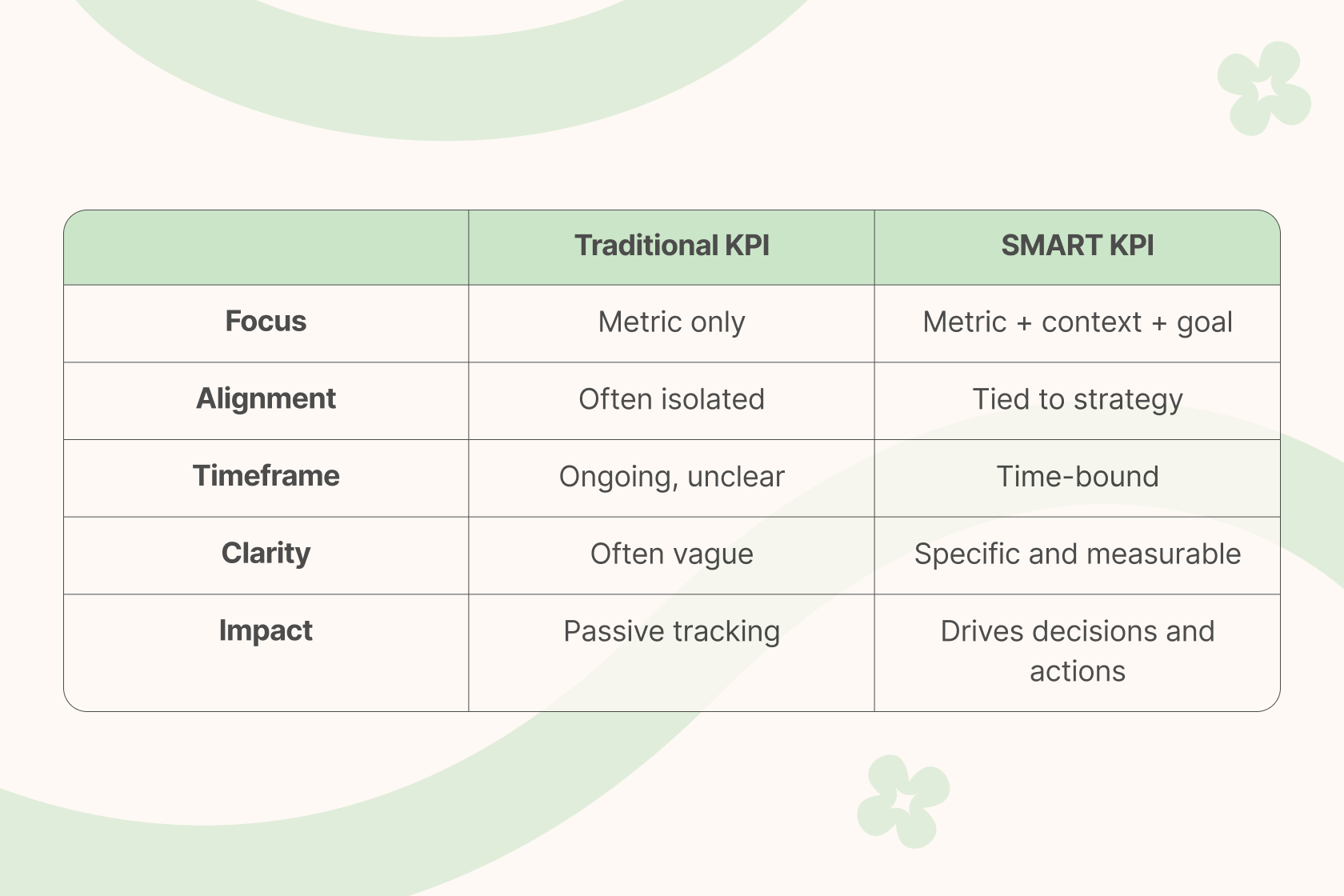In a world overloaded with metrics, it’s easy to track the wrong things or track the right things in the wrong way. That’s where SMART KPIs come in. They help HRs and managers focus on meaningful performance indicators that are clearly defined, trackable and actionable.
But what does it really mean to have SMART KPIs? And more importantly, how do you apply them in a way that drives measurable performance across teams? In this article, we’ll break down the concept of SMART KPIs, explore the most common mistakes companies make and offer a practical guide to creating and tracking meaningful indicators.
What Are SMART KPIs?
SMART is a well-known framework used to evaluate goals and performance indicators. The term stands for Specific, Measurable, Achievable, Relevant and Time-bound — five criteria that help ensure each KPI is clear, realistic, and aligned with what the business actually needs to achieve.
- Specific
A specific KPI focuses on clearly defined outcomes, avoiding vague or general goals. Vague goals like “Improve productivity” aren't helpful because they don’t explain what success actually looks like. A specific KPI answers the question: What exactly are we measuring, and why does it matter?
For example, instead of “Improve customer support,” the specific KPI would be “Reduce average first response time to customer support”.
- Measurable
A measurable KPI includes a clear metric, something you can track with data. This helps evaluate progress and make timely adjustments.
Example: “Increase monthly unique website visitors from 5,000 to 7,000”.
- Achievable
Answer the question: Is this goal realistic? An achievable KPI sets a challenging but realistic target, based on available time, skills, tools and budget. A goal that is too ambitious can frustrate the team, while one that’s too easy won’t drive meaningful results.
- Relevant
A relevant KPI connects directly to team’s and company’s strategic goals. It should directly connect to strategic business objectives, rather than being just a random metric.
- Time-bound
This KPI sets a deadline for achieving the goal. It creates focus and urgency, and makes it easier to plan and track progress.
Do SMART KPIs Actually Matter, and Do They Always Work?
When KPIs are too general, disconnected from the company’s strategy or employee goals, they lose meaning and value. Teams may not understand what is expected of them and performance loses effectiveness. This is why SMART KPIs’ve become a common practice.
Well-formulated SMART KPIs bring structure and help:
- Align teams around what truly matters
- Make progress measurable and visible
- Create a shared understanding of overall success
- Connect everyday work to company goals
But while the SMART framework is helpful, it’s not a silver bullet. Not all SMART KPIs are effective in practice…
Do SMART KPIs Always Work?
Even if a KPI has all the SMART criteria, it doesn’t automatically mean it’s right for your business. For example, you can set a specific and measurable KPI. But it still might not be connected to a larger strategic goal.
SMART KPIs work best when they’re connected to strategy. To make KPIs truly effective, go beyond the SMART checklist:
- Start with strategy. Begin with your company’s mission and long-term vision.
- Set meaningful goals. Make sure your goals drive progress but are based on reality (realistic tasks, employees, available resources, etc.)
- Align KPIs with actions. Develop action plans around each KPI so teams know exactly what to do.
- Review your metrics regularly. No KPI should be static and permanent. Review your metrics as your business evolves and your priorities change.
SMART is a starting point, but not a formula for success. Make sure every KPI you set is grounded in strategy, tied to outcomes and can be adapted as your business grows.
How to Create a SMART KPI That Actually Works
Creating a SMART KPI is about ensuring that your metrics drive strategic outcomes. While the SMART framework is widely used, most companies either oversimplify it or skip crucial steps in making KPIs. Let’s break down how to do it right.
- Start with your business goal
Before thinking about KPIs, be clear on what you want to achieve at a strategic level. The KPI should reflect progress toward this goal.
- Make it specific
Your KPI should be clearly defined.
- Ensure it’s measurable
You need a reliable way to track metrics. If they can't be measured, they can't be managed. For example, systems for setting and tracking goals, and make sure you have regular access to this data.
- Keep it achievable
A KPI should be ambitious but realistic. Setting an unreachable target will only demotivate your team.
- Make it relevant
Is this KPI connected to a strategic business priority? A KPI should support your company’s larger objectives.
- Set a time frame
Without a time limit, there’s no sense of urgency or accountability. Define whether this is a weekly, monthly or quarterly KPI.
- Assign ownership
Every KPI needs a clear owner, someone who is responsible for monitoring and driving progress. This helps avoid confusion and ensures accountability.
- Choose a tool to track it
Avoid spreadsheets when possible. A centralized, easy-to-read dashboard (like Okrate) allows teams track performance in real time and stay aligned without wasting hours on manual reporting.
Common Mistakes When Setting KPIs
These mistakes can lead to misaligned goals, wasted resources and disengaged teams. Here's what typically goes wrong and how to fix it:
- KPIs are too vague or too broad
When KPIs are general, teams don’t know what success actually looks like. Fix this by being specific and adding numbers, deadlines and ownership.
- Measuring what’s easy, not what matters
The presence of a metric doesn't mean it's useful. Metrics don't always reflect true performance. Always ask: Does this metric drive meaningful action or outcomes?
- Setting too many KPIs at once
Prioritize 3 – 5 KPIs per team or initiative. Fewer metrics make it easier to stay focused and track progress consistently.
- KPIs not linked to business goals
This is one of the most common and most harmful mistakes. If a KPI doesn’t clearly support a larger strategic objective, it adds noise. Each KPI should answer the question: How does this help us achieve our business mission or priorities?
- Manually tracking KPIs in spreadsheets
Manual tracking is slow and time-consuming. It also reduces update frequency and transparency. Invest in a system with visual dashboards that are easy to update and accessible to all teams. This will make KPI data more meaningful and user-friendly.
How to Track SMART KPIs Effectively
Setting SMART KPIs is only half the job. To make them actionable and meaningful, you need to track them consistently and in a way that’s easy for both managers and team members to use.
The best way to do this is with a KPI dashboard — a centralized visual system that gives everyone clear visibility into current progress and next steps. A well-designed KPI dashboard doesn't just show numbers. So what does an effective KPI dashboard need to include?
1) Clear, visual layout
The dashboard should present data in a simple and intuitive format with visual indicators like progress bars, status tags and graphs. Everyone should be able to glance at it and immediately understand what’s going on.
2) Real-time or automated updates
The more automated your tracking is, the more often it gets used.
3) Goal history
It's not just where you stand now, but also how your performance is changing. Teams should be able to see past versions of goals, comments and updates. A good dashboard should allow teams to track trends over time, compare progress with past results, and see how individual initiatives or team efforts are contributing to achieving goals.
4) Adaptability
The business environment is changing, and key performance indicators should evolve with it. Your system should allow you to adjust KPIs as needed. This ensures that KPIs remain relevant and consistent, rather than static or outdated.
5) Collaboration features
KPI tracking shouldn't be a one-way process. Tools should allow for commenting, reviewing data and approval, so teams can discuss progress, identify problems and agree on next steps. This helps make KPI tracking a regular and collaborative process, not a one-time report.
6) Accessibility and ease of use
The KPI system should be user-friendly and understandable. Users should be able to find the right goals, see the status and understand what's happening. Tools that are overly complex or difficult to use will be ignored by employees.
SMART KPIs vs Traditional KPIs
While many KPIs are just tracked metrics, SMART KPIs are designed with clarity, strategy and action in mind. The key difference lies in intention and structure.

KPIs only work when they're relevant. When they're reviewed, discussed and adjusted. When they reflect not just goals but also the team's actual direction.
Value isn't in perfect metrics. It's in creating a rhythm where people work in alignment, goals are visible and progress becomes part of the conversation. This is where SMART KPIs can truly make a difference, not because they follow a formula, but because they help focus on what's truly important.
Value isn't in perfect metrics. It's in creating a rhythm where people work in alignment, goals are visible and progress becomes part of the conversation. This is where SMART KPIs can truly make a difference, not because they follow a formula, but because they help focus on what's truly important.
